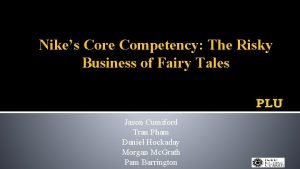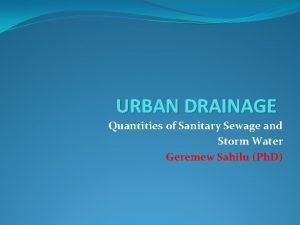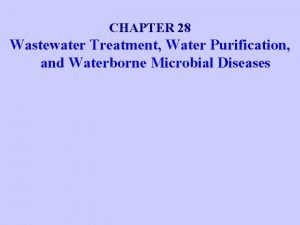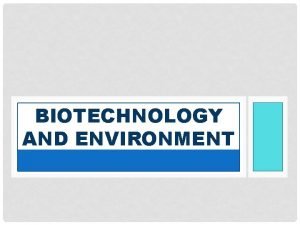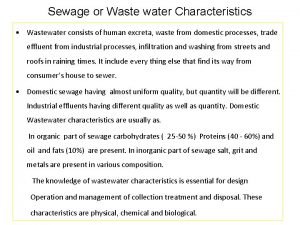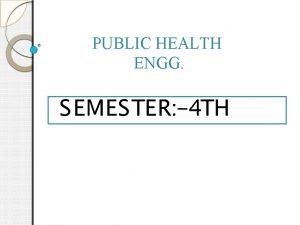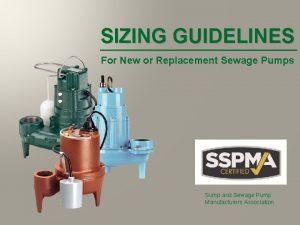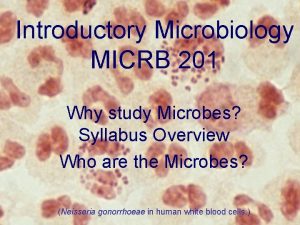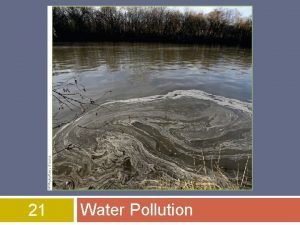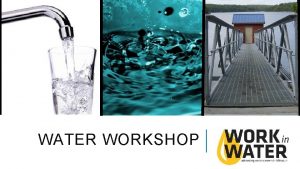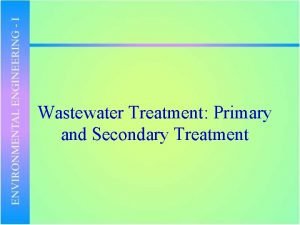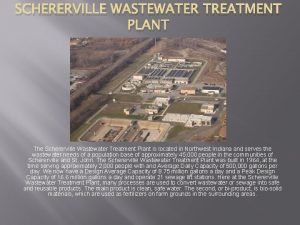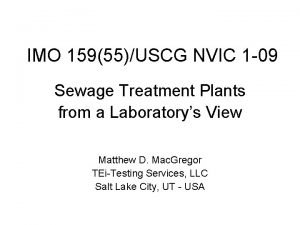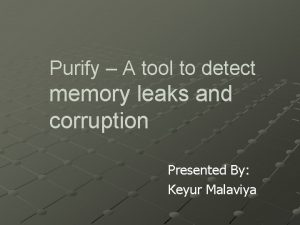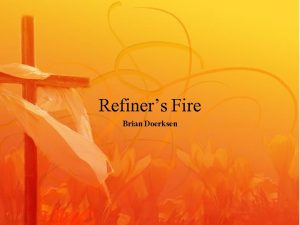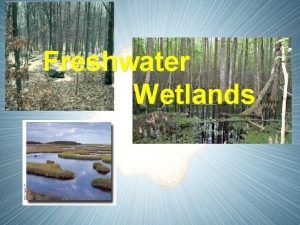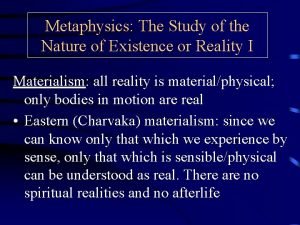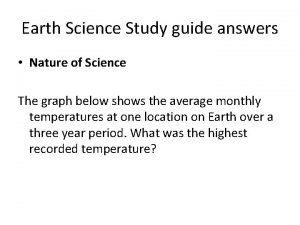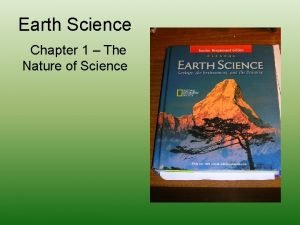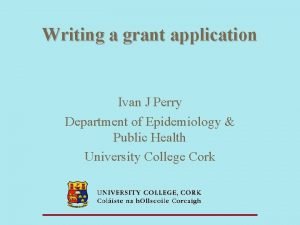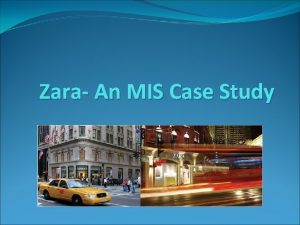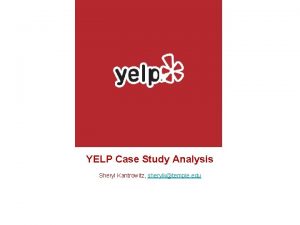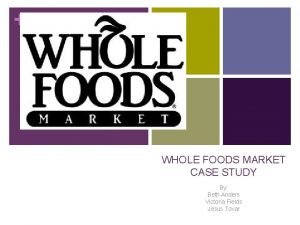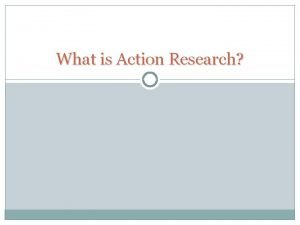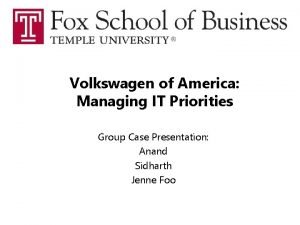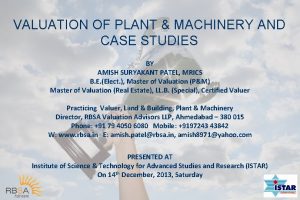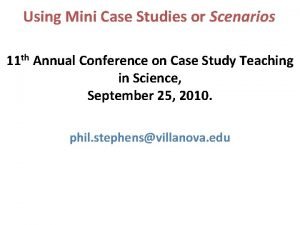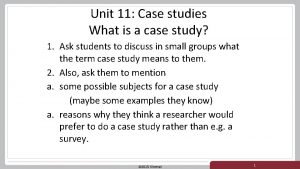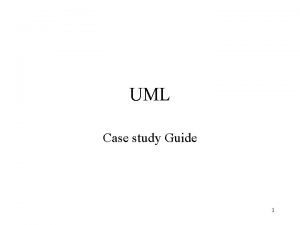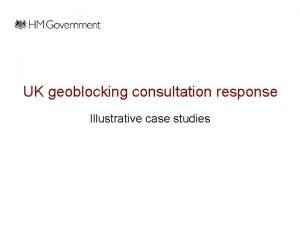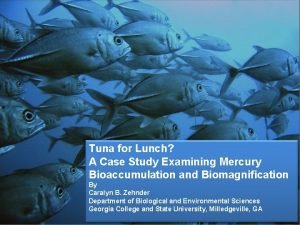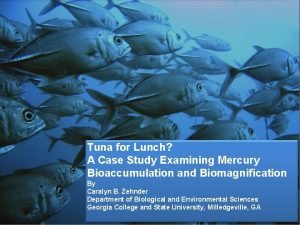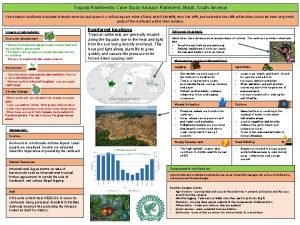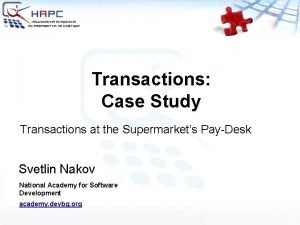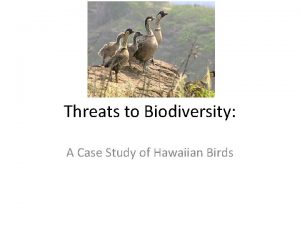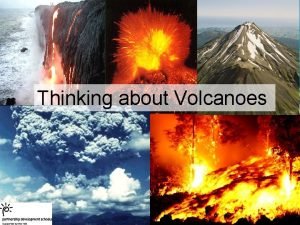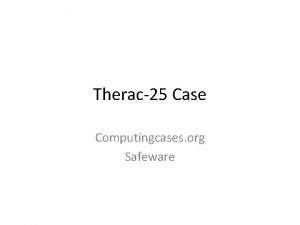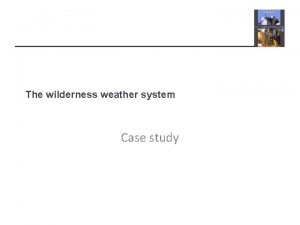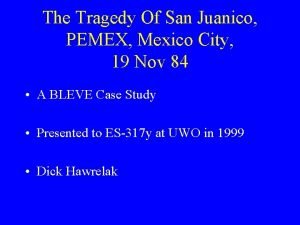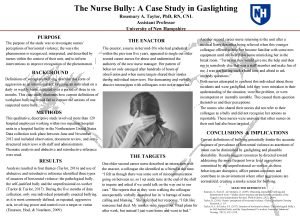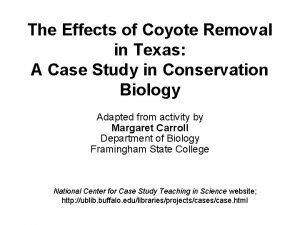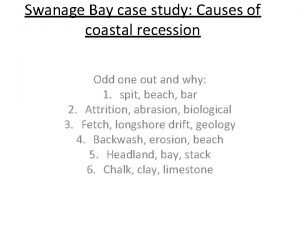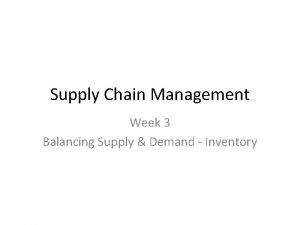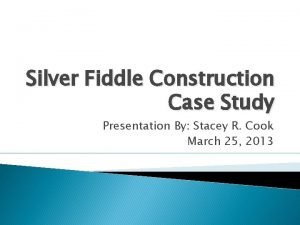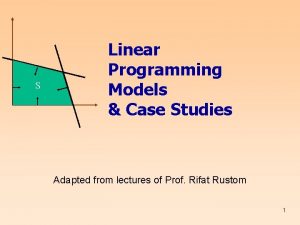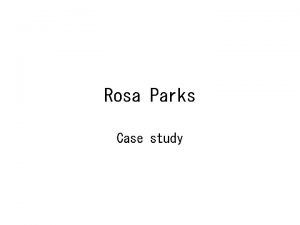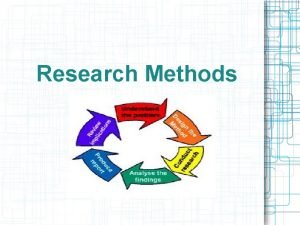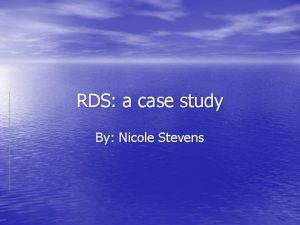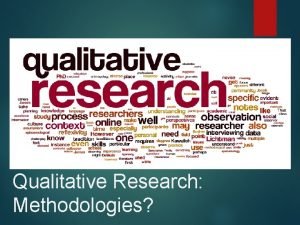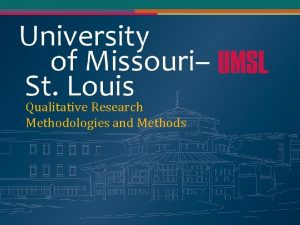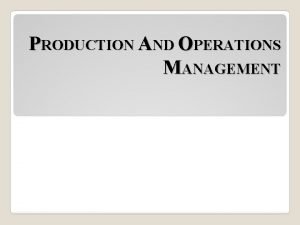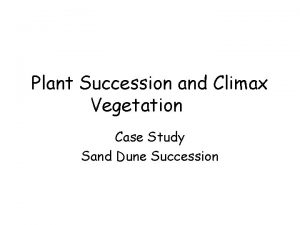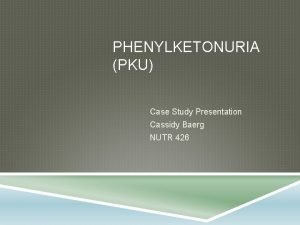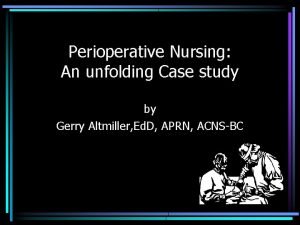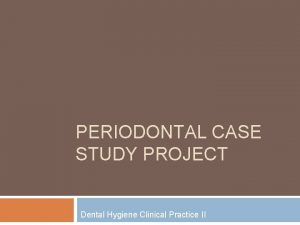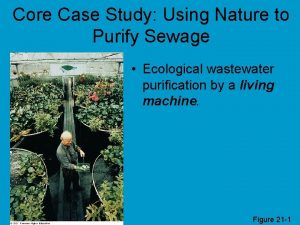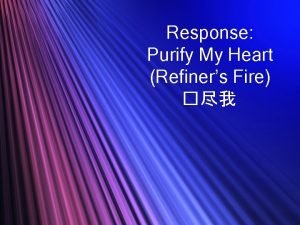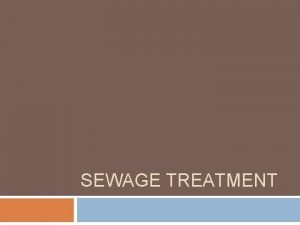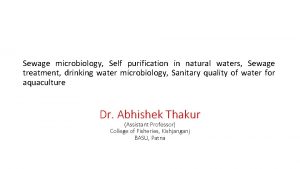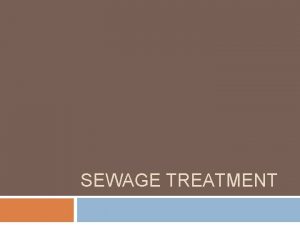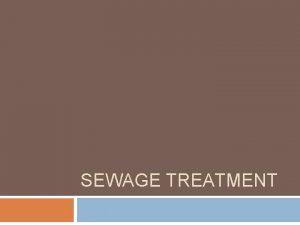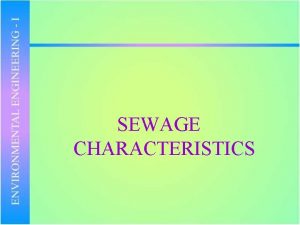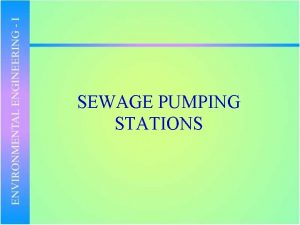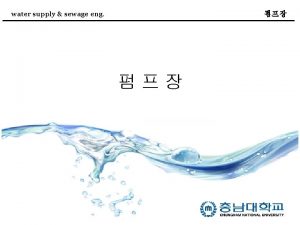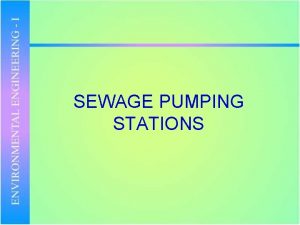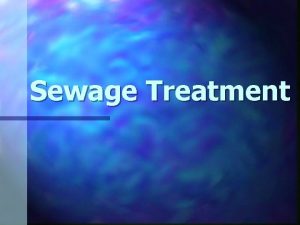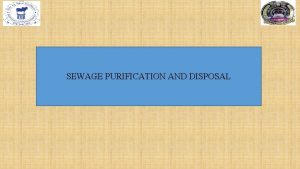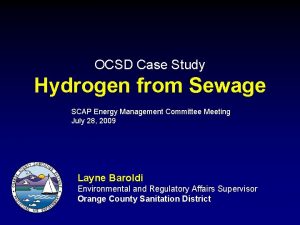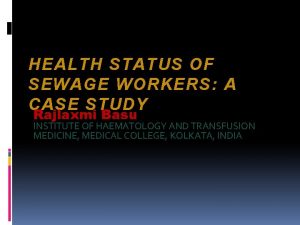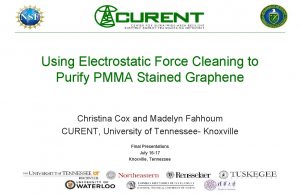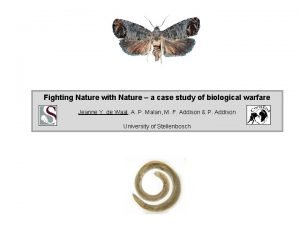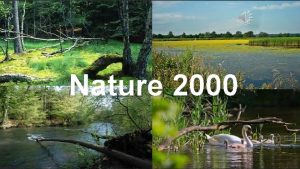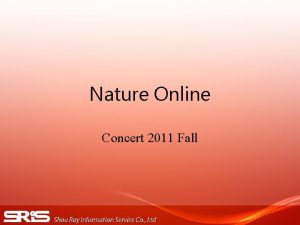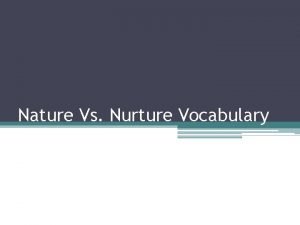Core Case Study Using Nature to Purify Sewage



















































































- Slides: 83


Core Case Study: Using Nature to Purify Sewage(利用自然以淨化污水) • Ecological wastewater purification by a living machine. 藉活化機器 以生態式淨化污水。 -Uses the sun and a series of tanks containing plants, snails蝸 牛, zooplankton浮游動物, crayfish 淡水螯蝦, and fish (that can be eaten or sold for bait餌). – 使用陽光及一系列水槽,內含 植物、蝸牛、浮游動物、浮游 動物、淡水螯蝦、魚(即可食 用或出售為餌)。 Figure 19 -1

重 要 觀 念 Ø Types, sources, and effects of water pollutants Ø Major pollution problems of surface water Ø Major pollution problems of groundwater Ø Reduction and prevention of water pollution Ø Drinking water quality


Major Water Pollutants and Their Effects主要水污染物及其影響 • A fecal coliform bacteriatest is used to indicate the likely presence of disease -causing bacteria in water. • 排泄物大腸菌群測試 是用來說明在水中 可能存在的致病細菌。 Figure 21 -2

Types, Effects and Sources of Water Pollution水污染的類型、影響及來源 Ø Point sources 點源 Refer to Tables 22 -1 and 22 -2 p. 492 and 493 Ø Nonpoint sources 非點源 Ø Water quality 水質 Fig. 22 -3 p. 494

Point(點源) and Nonpoint Sources(非點源) NONPOINT SOURCES Rural homes 農宅 Cropland 耕地 Urban streets 市街地 Animal feedlot 畜養場 Suburban development 郊區開發 POINT SOURCES Wastewater treatment plant 污水處理廠 Factory 廠

三、水污染的來源 • The leading sources of water pollution are agriculture, industries, and mining. 水污染的主要來 源是農業, 業和採礦業。 • 1. Agricultural activities are the leading cause of water pollution from erosion, overgrazing, fertilizers and pesticides, and excess salt from irrigated soils. 農業活動是水污染的主要原因,這些來 自於:侵蝕,過度放牧,化肥和農藥,灌溉土壤中過量 的鹽。 • 2. Industrial facilities are another large source of water pollution, and mining is a third source. 大型 業設施是另一個主要的水體污染源,採礦則是第三個 來源。

A. Water is polluted by infectious bacteria, inorganic and organic chemicals, and excess heat. 水污染是因細菌感染、無機和有機化學品、多餘的熱 • 1. Water pollution is any chemical, biological, or physical change in water quality that has a harmful effect on living organisms. 水污染是指水質產生化學、生物或物理變化, 此對生物體有害的影響。 • 2. Table 19 -1 lists the major classes of water pollutants and their major human sources and harmful effects. 表 191列出了主要水污染物類別及其主要人類來源和有害影響。 • 3. The WHO estimates that 3. 4 million people die prematurely each year from waterborne diseases. 世衛組 織估計,每年從飲水傳染疾病而過早死亡有340萬人,。 • 4. In the U. S. , an estimated 1. 5 million people a year become ill from infectious agents(傳染媒介). 在美國,估 計有150萬人因傳染媒介而生病。

四、主要的水污染物質 (一)傳染源-INFECTIOUS AGENTS • Examples: Bacteria(細菌), viruses(濾過性病毒 ), protozoa(原生動物), and parasitic worms(寄 生蟲) • Major Human Sources: Human and animal wastes(人畜廢棄物) • Harmful Effects: Disease(疾病) measuring the number of colonies菌落 of fecal coliform bacteria (大腸菌)present in a water sample. (EX美國菠菜遭水污染事件)

(二)耗氧性廢污 OXYGEN-DEMANDING WASTES • Examples: Organic waste such as animal manure(堆肥) and plant debris(殘枝) that can be decomposed by aerobic (oxygen-requiring) bacteria(由需氧菌分解) • Major Human Sources: Sewage下水道污物, animal feedlots(畜養場), paper mills造紙廠, and food processing facilities(食品加 廠) • Harmful Effects: Large populations of bacteria decomposing(細菌分解) these wastes can degrade water quality by depleting減少 water of dissolved oxygen(溶解氧). This causes fish and other forms of oxygenconsuming aquatic life(水生物) to die.

(三)水溶性無機化學製品 INORGANIC CHEMICALS • Examples: Water-soluble 1) acids, (2) compounds of toxic metals(有毒金屬化合物) such as lead (Pb鉛), • arsenic (As砷), and selenium Se硒), and (3) salts such as sodium chloride (Na. Cl) in ocean water and fluorides (F–氟 化物) found in some soils • Major Human Sources: Surface runoff, industrial effluents放流物, and household cleansers(清潔劑) • Harmful Effects: Can (1) make fresh water unusable for drinking or irrigation, (2) cause skin cancers and crippling spinal and neck damage (F–), (3) damage the nervous system (神經系統), liver, and kidneys(腎) (Pb and As), (4) harm fish and other aquatic life, (5) lower crop yields, and (6) accelerate corrosion of metals exposed to such water. ( 加速水中金屬腐蝕)

(四)有機養料 PLANT NUTRIENTS • Examples: Water-soluble compounds(水溶性化合物) containing nitrate (NO 3 – 硝酸鹽), phosphate (PO 43– 磷酸鹽), and ammonium (NH 4+ 氨鹽基) ions(離子) • Major Human Sources: Sewage, manure堆肥, and runoff of agricultural and urban fertilizers • Harmful Effects: Can cause excessive growth of algae(海藻) and other aquatic plants, which die, decay, deplete water of dissolved oxygen, and kill fish. Drinking water with excessive levels of nitrates lowers the oxygen-carrying capacity of the blood and can kill unborn children and infants (“blue baby syndrome”併 發症).


Water Quality Do (ppm) at 20˚C Good 8 -9 Slightly polluted 6. 7 -8 Moderately polluted Heavily polluted Gravely polluted 4. 5 -6. 7 Below 4. 5 Below 4 溶氧度,是用來測量在一大氣壓, 20˚C時液體中的溶氧含量,最常用的兩種測量單 位是ppm,或飽和百分率(%)-也就是溶解在 1公升水中的溶氧百分率



水的自清作用影響要素(續) • 2. The breakdown of pollutants(污染物的分解) by bacteria creates an oxygen sag curve(氧氣消減曲 線). Organisms that have a high oxygen demand can’t survive in the curve. 。藉由細菌分解污染物的 過程,產生了氧氣凹陷曲線。具有較高的氧需求的生 物體因而無法存在該曲線中。 • 3. Volume of the stream, volume of wastes entering, flow rate, temperature, and p. H levels all affect how great a sag curve is produced. 23。河 流體積,廢棄物進入量,流速,溫度和p. H值的水準, 都會影響凹陷曲線產生程度。


Pollution of Streams Ø Oxygen sag curve Ø Factors influencing recovery Fig. 22 -5 p. 496



A. MDC的有毒化學製品、非點 源污染仍嚴重 • 1. The U. S. has managed to avoid increases in pollution from point sources in most streams. 美國一直設法避免增 加大多數的點源污染。 • 2. There have been several examples of amazing cleanup of rivers, such as the Cuyahoga River in Ohio and the Thames River in Great Britain. 已有幾個清理河 流例子, 如在俄亥俄州凱霍加河和英國的泰晤士河。 • 3. There are still examples of large fish kills and contamination of drinking water(飲水污染) from releases of chemicals from industry and mining, and also from non-point runoff of fertilizers and pesticides(肥料、殺蟲 劑). 仍然有大量魚類死亡和飲用水污染的例子,這是源自 於釋放出的化學品 業和採礦,以及從非定點逕流化肥和 農藥(肥料,殺蟲劑)。

B. LDC河川污染依然嚴重 • 以印度恆河為例,宗教信仰、傳統文化、貧窮、經濟發展 程度較低、人口眾多,導致恆河嚴重污染: • 1. About 350 million people live in the Ganges River basin with little treatment of sewage produced by them. 約有 3. 5億人生活在恒河流域,但所產生的污水沒有作多 少處理。 • 2. Hindu(印度人) beliefs add pollution to the air when bodies are cremated(火化遺體) and to the water when partially cremated or non-cremated bodies are thrown into the river in order to find their way to heaven(找到去 天堂的路). 印度人的信仰卻增加了空氣的污染,每當火化 遺體,有些部分火化或不火化屍體被扔進河裡,以便找到 通往天堂的路。

印度恆河污染因素(續) • 3. The government is working to clean up the river by building waste treatment plants(污水處理廠) in the 29 large cities along the Ganges(恆河) and by building electric crematoriums(電動火化場) on its banks. It has also introduced(引進) snapping turtles(海龜) as body scavengers(食腐動物). 政府正在努力清理河道,這是通 過在沿恒河(恒河) 29大城市建立廢棄物處理廠(污 水處理廠)和在其河岸興建電動火化場。它還引進生猛 海龜,以為屍體的清道夫(食腐動物)。 • 4. Most of these plans are not yet in place, and religious and cultural conditions are difficult to change. 但大多數這些計劃還沒有到位,況且宗教和文 化條件難以改變。

(三)、湖泊、水庫之污染 • A. Lakes have little flow and so are less effective at diluting pollutants that enter them(少有流動→釋污力↓). 湖的流量小,稀釋進入湖內污染物效率低。 • 1. Lakes and reservoirs are often stratified into layers( 分層現象) with little vertical mixing, and they also have very little flow occurring. It may take from 1– 100 years to flush(湧流) and change water in lakes and reservoirs. 湖 泊和水庫常有分層現象且少有混合垂直,而且少有流量發 生。它可能需要從 1 -100年才有湧流,及改變湖泊和水庫 的水。 • 2. Lakes and reservoirs are much more vulnerable(脆弱 的) to runoff contamination of all kinds of materials. 湖泊 和水庫的逕流易遭各種物質污染。 • 3. Chemical concentrations(濃度↑) build up as they pass through the food webs in lakes. 化學濃度(濃度↑)將通 過湖泊的食物網而加大。

(三)、湖泊、水庫之污染 • B. 人類活動導致湖內含養過量→DO↓→水生物死亡 • 1. Natural nutrient enrichment of lakes from runoff is called eutrophication. The amount of natural eutrophication depends on the composition of the surrounding drainage basin(流域面積). • 湖泊從逕流帶入營養豐富的天然物被稱為優養化。天然水 體優養化的數額取決於周圍排放水域的組成。 • 2. Natural eutrophication can enrich the abundance of desirable organisms, but cultural eutrophication occurs near urban or agricultural areas and can lead to serious pollution problems. • 天然優養化可以豐富有機體,但文化優養化卻發生在城市 或農業地區附近,並可能導致嚴重的污染問題。

優養化現象(續) • 3. During hot weather or drought, “blooms” of organisms can reduce lake productivity. • 在炎熱的天氣和乾旱之時,一叢叢的生物體將減少湖泊的 生產力。 • 4. Reduced sunlight and the subsequent decomposition(隨後分解) of the “blooms” increase populations of bacteria and decreases dissolved oxygen (DO) ↓available. • 陽光減少照射,隨後這些植物叢的分解,將會增加細菌量, 減少可用的溶解氧(DO)↓。 • 5. Fish kills can occur, and the problem can become so bad that anaerobic bacteria(厭氧菌) take over. • 魚類死亡可能發生,且一旦厭氧菌到處滋生,問題將會變 得更糟糕。


Discharge of untreated municipal sewage (nitrates and phosphates) Nitrogen compounds produced by cars and factories Natural runoff (nitrates and Natural runoff phosphates Discharge of detergents ( phosphates) Discharge of treated municipal sewage (primary and secondary treatment: nitrates and phosphates) Dissolving of nitrogen oxides (from internal combustion engines and furnaces) (nitrates and phosphates Lake ecosystem nutrient overload and breakdown of chemical cycling Inorganic fertilizer runoff (nitrates and phosphates) Manure runoff from feedlots (nitrates, phosphates, ammonia) Runoff from streets, lawns, and construction lots (nitrates and phosphates) Runoff and erosion (from cultivation, mining, construction, and poor land use)








Case Study: The Great Lakes Fig. 22 -8 p. 500

C. 案例:北美五大湖(the Great Lakes)的污染和清除 • 1. The Great Lakes contain about 95% of the fresh surface water in the United States, and one-fifth of the world’s fresh surface water. 大湖水體約占美國地表淡水的 95%,以及和世界地表淡水的五分之一。 • 2. At least 38 million people obtain drinking water form the lakes. 這些湖泊供應3800萬人飲水。 • 3. The lakes are vulnerable to pollution(易受污) because they have less than 1% outflow to the St. Lawrence River, and there is land runoff and atmospheric deposition(大氣 沈澱物) of acids, pesticides, etc. being blown into them. 這 些湖泊容易受到污染,因為他們流到聖勞倫斯河的水量已 經低於 1%,且土地的逕流和含酸的大氣沉澱物、農藥, 也被吹到湖中。 • 4. Lake Erie is the shallowest(淺) of the lakes and was the most polluted, due to the highest concentration of people and industry. 伊利湖是最淺的湖泊,曾經污染最 嚴重,因其為人口和 業高度聚集地。

北美五大湖的污染和清除(續) • 5. Since 1972, the U. S. and Canada have worked together to reduce pollution. 自 1972年以來,美國和加拿大共同努力 減少污染。 • 6. There are still problems to be solved such as a large area of depleted oxygen(耗氧) that occurs in the center of the lake each August for unknown reasons. 但還有問題需 要解決,如每年八月發生在湖中心的耗氧面積廣大,其原 因不明。 • 7. A 2000 survey by the EPA stated that more than threefourths of the shoreline(湖岸線) of the Great Lakes is not clean enough for swimming or use as drinking water. 大湖 區水質欠佳。按美國環保局 2000年的調查指出,大湖區超 過四分之三的湖岸線並不乾淨,不能游泳或用作飲用水。 • 8. Non-point land runoff is a greater problem than industrial pollution now for the Great Lakes. 在大湖區,現 在非點源的土地逕流,比 業污染的問題更大。

北美五大湖的污染和清除(續) • 9. Bio magnification of the depositions from atmospheric contaminants means that one fish in four is unsafe for human consumption. (大氣污染沈澱物之 生物性擴大↑, 表示 1/4的魚不能供人安全的食用。 • 10. EPA funding for cleanup has also dropped by 80% since 1992. 自 1992年, 環保局清理資金已經下降 了80%。 • 11. Environmentalists call for banning the use of bleach(禁用漂白劑), building new incinerators(焚化爐 ), and stopping the discharge(放流水) into the lakes of 70 toxic chemicals. 環保人士呼籲禁止使用漂白劑,興 建新的垃圾焚化爐,並禁止將70種有毒化學物質排放到 湖中。

七、地面水污染之防治 • 地面水污染較易查覺,監控亦較地下水相對容易。其防 治之方法:定點與不定點污源防治法 – A. 減少地面水非點源污染的方法; – 1. Agricultural non-point pollution can be reduced by reducing soil erosion減少土壤侵蝕, reforestation造 林 of watersheds, keeping cover crops(覆蓋作物) on farmland, reducing fertilizer use or using slowrelease fertilizer, and planting buffer zones(緩衝帶) between farmland surface water nearby. 農業非 點源污染,可藉由減少土壤侵蝕、在流域造林、農 地上保持覆蓋作物、減少化肥使用或使用緩釋肥, 農田和附近地表水之間栽植緩衝地帶。 – 2. Rely more on biological control methods (生物控 制法)rather than pesticides. 更為依賴生物控制方法, 而不是農藥。


A. 不定點污源之防治-美國 • 3. In 2002, a federal court forced the EPA to uphold( 支持) the intent of the Clean Water Act and require 15, 500 of the largest feedlots(飼養場) to apply for EPA permits(許可). 2002年,聯邦法院強制環保局支持淨水 法案的意圖,並要求15, 500最大飼養場需向環保局申請 許可。 (需先申請許可,方可飼養) • This means that these “factories” will have to obey the same pollution controls that are used by other industries since 1972. 這意味著,這些“ 廠”將不得不 遵守自 1972年以來用來管控其他 業的措施。 • 同樣的污染控制所使用的4. Research on how to use animal wastes more effectively is underway. 3。 (需先申請許可,方可飼養) 4。研究如何更有效地利用牲畜糞便正在進行。

A. 不定點污源之防治-美國 • 1. The Clean Water Act sets standards for allowed levels of key water pollutants and requires polluters to obtain permits that specify the amounts of pollutants they can discharge into aquatic systems. (清潔水法規定排放流標準 , 並要求污染者需先取得排放許可證,指定可排放入水系統 之污染物數量) • 2. The EPA is experimenting with a discharge trading policy that would allow a permit holder to purchase unused credits from another permit holder. (美國環保局正 在試驗一種排放流貿易政策 --污染許可證可予交易,未用 餘額可以賣給他人) • 3. There are good and bad points to credit trading, such as a possible buildup of pollutants in areas where credits are bought. (排污權買賣有好有壞-徒使購買排污權的地區 污源增加)


Global Outlook: Stream Pollution in Developing Countries 全球展望:發展中國家的河流污染 • Water in many of central China‘s rivers are greenish black from uncontrolled pollution by thousands of factories. 在中國中部許多河流的 水呈墨綠色,這是從數 以千計的不受控制的污 染 廠排出。 • 廠排放廢污未處理 Figure 21 -5

C. 定點污源之防治 • 1. About one-fourth of homes in the U. S. are served by septic tanks(化糞池). 在美國,約有四分之一的住宅 供應化糞池。 • 2. Most urban areas are served by sewage treatment plants(污水處理廠). 大多數城市都提供有污水處理廠。 • 3. Some 1, 200 cities have combined storm runoff and sewer lines because it is cheaper(雨水、污水下水道 未分立). These systems can overflow溢滿 and discharge untreated sewage directly into surface water with too many users or when there is a heavy storm. 約 1200個城市已有聯合雨水逕流和下水道,因 為這樣較便宜。但用戶太多或有一場暴風雨時,這些系 統會溢滿,並排放未經處理的污水直接排入地表水。

C. 定點污源之防治(續) • 4. Aging sewer systems(老化污水處理系統) and combined sewer systems in the U. S. are estimated to cost $10 billion a year for 10 years to install dual systems, add capacity, and repair the aging sewer network. 美國老化的下水道系統,和下水道系統相結合, 估計需在 10年間耗資 100億美元來安裝雙組(分立)系 統,以增加容量,並修復老化的污水管網。 5. Raw sewage generally undergoes one or two levels of treatment. 污水一般須經一、二級處理 • 6. Primary sewage treatment is a physical process that removes grit(砂礫), floating objects(漂浮物), and suspended solids(懸浮微粒). A settling tank(沈澱池) allows suspended solids to settle out as sludge(污泥). 一 級污水處理是一種物理過程,可消除砂礫、漂浮物、懸 浮固體(懸浮微粒)。一個沉澱池允許懸浮固體可以處 理為污泥。

Secondary Primary Grit Bar screen chamber Settling tank Chlorine Aeration tank Settling tank disinfection tank To river, lake, or ocean Raw sewage from sewers Sludge (kills bacteria) Activated sludge Air pump Sludge digester Sludge drying bed Figure 19 -17 Page 504 Disposed of in landfill or ocean or applied to cropland, pasture, or rangeland

C. 定點污源之防治(續) • 7. Primary treatment removes about 60% of suspended solids 懸浮微粒 and 30– 40% of organic wastes, but no phosphates, nitrates, salts, radioisotopes(放射性同位素), or pesticides. 一級 污水處理去除約 60%的懸浮微粒和30 -40%的有機廢物,但無法 去除磷酸鹽,硝酸鹽,鹽類,放射性同位素,或殺蟲劑。 • 8. Secondary sewage treatment is a biological process where aerobic bacteria需氧菌 remove up to 90% of dissolved and biodegradable生物分解, oxygen-demanding organic wastes. 二 級污水處理是一種生物過程,其中好氧菌去除高達 90%的溶解 和生物可降解、需氧的有機廢物。 • 9. A combination of primary and secondary treatment removes 95– 97% of the suspended solids and oxygen-demanding organic wastes, 70% of most toxic metal compounds金屬化合物 , 70% of phosphorus磷, 50% of nitrogen氮, and 5% of dissolved salts. 一個結合一級和二級的污水處理,可消除 95 -97%的懸浮固 體和需氧的有機廢物,70%的多數有毒的金屬化合物,70%的磷, 50%的氮,及5%的溶解鹽。

C. 定點污源之防治(續) • 10. Most U. S. cities have combined primary and secondary sewage treatment plants. A number of cities have been in violation at times, and 34 East Coast cities screen out(擋住) large floating objects and discharge sewage into coastal waters. 大多數美國城市 已有一級和二級聯合污水處理廠。一些城市有時違反常 情,有34個東海岸城市擋住了大型漂浮物和排放污水到 沿岸水域。 • 11. Tertiary sewage treatments(三級污水處理) are a third level of cleanup. Here, a combination of chemical and physical processes remove specific pollutants left by the other methods. This is expensive and used to treat only 5% of the wastewater in the U. S. 11。三級 污水處理是第三個層次的清理。在這裡,化學和物理的 組合過程,去除特定污染物而留下其他的方法。這是昂 貴的,在美國只有5%的廢水用此方法處理。

C. 定點污源之防治(續) • 12. Water is bleached(漂白) to remove colors and then disinfected(消毒殺菌) to kill diseasecausing bacteria and some viruses(濾過性病 毒). Chlorination(加氨消毒) is the usual method of disinfection(消毒法). 將水加以漂白、 除色,然後進行消毒,以殺死致病細菌和一些 病毒。而加氨消毒是通常的消毒方法。 • 13. Ozonation(臭氧) and use of ultraviolet light(紫外線) are increasing as methods of disinfection消毒. 13。臭氧和使用紫外線,是越來越多被用來消 毒的方法。

Technological Approach: Advanced (Tertiary) Sewage Treatment (三級污水處理) Ø Uses physical and chemical processes 使用物理和化學過程 Ø Removes nitrate and phosphate 去除硝酸鹽和磷酸鹽 Ø Expensive 昂貴 Ø Not widely used 未被廣泛採用

D. 污水處理之污泥需妥予處理 • 1. Sludge is a thick, gooey mixture(膠黏混合物) of bacteria, solids, chemicals, and metals金屬 when industrial and household wastes are combined. 當 業和 家庭廢物相結合時,會產生污泥。污泥是一種粘稠的物體, 為細菌、固體、化學品、金屬混合成糊糊的混合物。 • 2. Some sludge undergoes anaerobic(厭氧的) digestion( 消化) to decompose(分解) the organic materials and produce compost(混合物). 一些污泥經過厭氧的消化作用, 以分解有機材料和製造堆肥。 • 3. About 36% of these biosolids are used to fertilize farmland, forests, golf courses, cemeteries, etc. The rest is added to landfills(垃圾掩埋場) or incinerated(焚化). 約 有36%的生物固體是用來施肥於農田,森林,高爾夫球場, 墓地等,其餘將被添加到垃圾填埋場或焚化。

D. 污水處理之污泥需妥予處理 • 4. Composting sludge to recycle(再利用) the plant nutrients makes good ecological sense, but removing infectious bacteria傳染菌, toxic chemicals, and metals is expensive and seldom done in the U. S. 污泥堆肥回收(再利用)植物的營養素,具有良 好的生態意義,但是,消除傳染病菌、有毒化學品以 及金屬的價格昂貴,故在美國很少這樣做。 • 5. It is thought that a number of health problems may be due to using sludge to fertilize crops in the U. S. (少用污泥施肥—健康因素) 。 • 一般認為,在美國有不少健康問題,可能是由於使用 污泥對作物施肥所致。

Odors may cause illness or indicate presence of harmful gases Dust Particles of dried sludge carry viruses and harmful bacteria that can be inhaled, infect cuts or enter homes. BUFFER ZONE Sludge Groundwater Contamination Harmful chemicals and pathogens may leach into groundwater and shallow wells. Surface Runoff Harmful chemicals and pathogens may pollute nearby streams, lakes, ponds, and wetlands. 少用污泥施肥—健康因素 Exposure Children may walk or play in fertilized fields. Livestock Poisoning Cows may die after grazing on sludgetreated fields.


E. 防止有毒化學物質進入污水處理廠 • 1. Require industries and businesses to remove toxic and hazardous wastes from water sent to sewage treatment plants; encourage reduction or elimination 除去 of toxic chemical use and waste. 1。需要 業和 企業消除含有毒和有害廢物的水,這需送到污水處理廠 ; 處理,並鼓勵減少或消除有毒化學品的使用和廢棄物。 • 2. Have households switch to waterless composting toilet systems maintained by professionals. These systems would be cheaper to install and maintain since they do not need underground pipes(無須設置 地下管線). 使用戶轉換到無水堆肥廁所系統,由專業 人士加以維護。這些系統的安裝和維護成本更低,因為 他們並不需要地下管道(無須設置地下管線)。

F. 運用自然和人 濕地處理污水 • 1. These systems are a low-tech, low-cost alternative to expensive waste treatment plants. 這些系統是低技術、 低成本的,以替代昂貴的廢棄物處理廠。 • 2. Sewage goes to sedimentation tanks(沈澱池) where solids settle as sludge that is removed. The liquid(液體) is pumped to oxidation ponds(氧化池); bacteria break down remaining wastes. After a month, water is released to an artificial marsh(人 沼澤) where plants and bacteria filter(濾除) and cleanse it. 2。污水流入沉 澱池,可將固體加以處理成污泥。液體被泵入氧化池中; 細菌分解將剩下一些廢物。一個月後,將水釋放到人 濕地,裡面有植物和細菌可過濾,使它潔淨。

F. 運用自然和人 濕地處理污水 • 3. Mark Nelson developed a small, low-tech, inexpensive artificial wetland system for use in developing countries at hotels, restaurants, and homes. It removes 99. 9% of fecal coliform bacteria(大腸菌) and over 80% of the nitrates and phosphates from sewage. The water thus cleaned could be used for garden irrigation or flushing toilets and save water. • 馬克尼爾森開發了一種小型、低技術、廉價的人 濕地 系統,以供發展中國家在酒店、餐館和家庭使用。它消 除 99. 9%的大腸菌群,和超過 80%的硝酸鹽和磷酸鹽的 污水。因此,清潔的水可用於園林灌溉或沖洗廁所,及 節約用水。

F. 運用自然和人 濕地處理污水 • 4. Genetic engineering(遺傳 程) is developing a bioreactor where modified bacteria will consume pesticides. • 4。基因 程(遺傳 程)正在開發一種生物反應 器,以利用改造的細菌以消耗農藥。 • 5. Without large investments in building adequate sanitation facilities, more people will have inadequate sanitation. (亟需供應公衛設施) • 5。如果沒有大量的投資在建設適當的衛生設施, 更多的人將沒有足夠的衛生設施。

(1) Raw sewage drains by gravity into the first pool and flows through a long perforated PVC pipe into a bed of limestone gravel. (3) Wastewater flows through another perforated pipe into a second pool, where the same process is repeated. Sewage Wetland type plants Treated water 45 centimeter layer of limestone First concrete pool gravel coated with Second concrete pool decomposing bacteria (2) Microbes in the limestone gravel break down the sewage into chemicals that can be absorbed by the plant roots, and the gravel absorbs phosphorus. Figure 19 -19 Page 506 (4) Treated water flowing from the second pool is nearly free of bacteria and plant nutrients. Treated water can be recycled for irrigation and flushing toilets.

• (1)Raw sewage drains by gravity into the first pool and flows through a long perforated PVC pipe into a bed of limestone gravel. 由未經處理的污水藉由重力進入第一池, 並流經長條穿孔PVC管到石灰岩礫石床。 • (2) Microbes in the limestone gravel break down the sewage into chemicals that can be absorbed by the plant roots, and the gravel absorbs phosphorus. (2)在石灰 岩礫石微生物將污水分解成化學物質,可以通過植物根系 吸收,而礫石可以吸收磷。 • (3) Wastewater flows through another perforated pipe into a second pool, where the same process is repeated. 廢水 流經另一穿孔管進入第二個池,而同樣的過程重複進行。 • (4) Treated water flowing from the second pool is nearly free of bacteria and plant nutrients. Treated water can be recycled for irrigation and flushing toilets. 從第二池流入 處理後的水,是從近乎沒有細菌和植物營養素。處理後的 水可循環用於灌溉和沖廁所。 • 45 centimeter layer of limestone gravel coated with decomposing bacteria 45厘米石灰岩礫石層塗有分解細菌



A. 地下水易受污染之特性 • 1. Spilling gasoline, oil, paint thinners(油漆稀釋劑 ), and other organics onto the ground can contaminate groundwater. 溢出汽油,機油,油漆 稀釋劑及其他有機物在地面上,從而污染地下水。 • 2. Experts rate groundwater pollution as a lowrisk ecological problem; it is rated as a high-risk health problem. 專家將地下水污染視為一個低風險 的生態問題,但它被評為高風險的健康問題。 • 3. Contaminated water in the aquifer(含水層) will slowly flow along and create a plume of contaminated water. 被污染水一旦進入含水層裡, 將慢慢流動,並形成一層層污染的水。

A. 地下水易受污染之特性(續) • 4. Contaminants in groundwater are not diluted(稀釋) or dispersed(驅散) because this water moves usually less than 0. 3 meter, or 1 foot per day. 地下水污染物並 不會稀釋或驅散,因為這些水流移動通常少於 0. 3米, 或每天少於 1公尺。 • 5. Factors such as lower oxygen content, colder temperature of the water, and smaller populations of decomposing bacteria mean that cleansing is extremely slow. 出現如低的含氧量,水溫較低,和分解 菌種群小等因素,意味著淨化將是非常緩慢。 6. It can take hundreds of years to cleanse degradable wastes; nondegradable wastes are there permanently. 它可能得花上數百年來淨化可分解廢物; 而不可分解的廢物將長期留存。

B. 地下水(含水層)監測欠缺 • 1. EPA and U. S. Geological Survey figures state that one or more organic chemicals contaminate about 45% of municipal groundwater supplies in the U. S. 據 EPA和美國地質調查局數據說明,有機化 污染,約占 美國的城市地下水供應的 45%。 • 2. Some 26, 000 industrial waste ponds and lagoons in the U. S. do not have a liner to prevent toxic waste seepage(滲流). 在美國,有 26000座 業廢水池和潟湖 (鹹水湖)沒有襯墊,難以防止有毒廢物滲漏。 • 3. A great many of the underground storage tanks(地 下儲存槽) containing organic solvents(有機溶劑) have been found to have leaks(裂縫). 大量的地下儲油槽含有 有機溶劑,已發現有洩漏情形。 • 4. Determining the extent of a leak is costly, and the cost of cleanup is more costly yet. 然要確定洩漏的程度 是昂貴的,且其清理成本甚至要更昂貴。

B. 地下水(含水層)監測欠缺(續) • 5. In China and India, millions of people drink water contaminated with high levels of fluoride(氟化物) that cause back and neck damage and dentalproblems. • 在中國和印度,成千上萬的人飲用受污染的水與高濃度 的氟化物,導致背部和頸部的損傷和牙齒的問題。 • 6. Nitrates(硝酸鹽) can also contaminate groundwater, especially in agricultural areas. Nitrates converting to nitrites(亞硝酸鹽) in the body can cause various forms of cancer and in babies under 6 months old causes “blue baby syndrome” because the blood can’t carry sufficient oxygen to the cells。 • 硝酸鹽也會污染地下水,特別是在農業地區。硝酸鹽轉 換為亞硝酸鹽,則在體內可引起各種形式的癌症,6個 月以下嬰兒將導致「藍嬰綜合症」,因為血液不能攜帶 足夠的氧氣給細胞之故。(血液帶氧量不足)

B. 地下水(含水層)監測欠缺(續) • 7. Arsenic(砷) is released into drinking water when a well is drilled(鑽孔) into arsenic-rich soils and rock. WHO estimates that more than 112 million people drink water containing 5– 100 times the recommended level of 10 parts/billion. 當鑽井時,如鑽孔到含砷的土壤和岩石,將 使砷被釋放到飲用水井。世衛組織估計,有超過 1. 12億人 飲用的水中含有10單位/十億建議含砷量的5 -100倍。 • 8. Bangladesh has a serious. problem with arsenic, but the UN and several NGOs have started a program to assess wells and mark those that are too contaminated with red paint. 孟加拉國有一個嚴重的砷問題,但聯合國和 一些非政府組織已開始進行一項計劃,評估一些水井,並 對那些過於污染者,噴上紅色油漆。 • 9. The 1 -ppb(十億分之一) level is considered to still be too high a level for safe drinking water. 就安全飲用水言, 十億分之一的水平,仍然被認為是過高的。

Solutions Groundwater Pollution Prevention Find substitutes for toxic chemicals找出有毒化學品的替代品 Keep toxic chemicals out of the environment讓有毒化學品遠離環境 Install monitoring wells near landfills and underground tanks在垃 圾填埋場和地下油罐附近安裝監測井 Require leak detectors on underground tanks對地下油罐裝置洩 漏探測器 Ban hazardous waste disposal in landfills and injection wells禁止 在垃圾填埋場和注水井處置危險廢物 Store harmful liquids in aboveground tanks with leak detection and collection systems在地面上有害液體儲 存槽,對其洩漏建立檢測和收集系統 Cleanup Pump to surface, clean, and return to aquifer (very expensive) 抽取到地表,清潔, 並回注到含水層(非常昂貴) Inject microorganisms to clean up contamination (less expensive but still costly)注入 微生物清除污染(較便宜,但仍然 昂貴) Pump nanoparticles of inorganic compounds to remove pollutants (may be the cheapest, easiest, and most effective method but is still being developed)抽取無機化合 物,去除污染物(可能是最便宜, 最簡單,最有效的方法,但仍處於 開發階段)



九、飲用水水質 (Drinking Water Quality) Ø Purification of urban drinking water Ø Protection from terrorism Ø Purification of rural drinking water Ø Safe Drinking Water Act Ø Maximum contaminant levels (MCLs) Ø Bottled water

九、飲用水水源水質 • 飲用水的水源,主要還是地面水與地下水,且其水質要求比 灌溉用水來得嚴格。飲用水淨化措施如下: • 1. Exposure of contaminated water to intense sunlight in a clear plastic bottle(透明塑膠管) is one method. It takes as little as 3 hours to kill bacteria in the sun and heat. 將受污染 的水裝在透明塑膠管,在強烈的陽光下曝曬,是一種好方法。 在陽光和熱之下,它只要短短 3個小時就能殺死細菌。 • 2. Cholera incidences(霍亂影響範圍) have been cut in half in Bangladesh by filtering water(濾水) through strips of cloth(棉織物). 在孟加拉國,霍亂發病率已減少了一半,這是 通過棉織物加以過濾水。 • 3. A third method is to add a small amount of chlorine to a plastic or clay storage vessel(管) with a small mouth, cap, and a spigot. This has cut the rate of diarrheal diseasein half in countries where it is used. 第三種方法是添加少量的氯的 塑料或粘土儲存管,開個小口,加蓋和水龍頭。使用它國家 裡,已削減一半的腹瀉疾病比率。

A. 飲用水質課題 • 約有54國訂有水質標準,但有如下課題: • 1. Levels have been established called maximum contaminant levels for any pollutants that may adversely affect human health. 所謂污染物的各級最 高標準已經建立,這是按污染物是否會影響人體健康 而定。 • 2. Privately owned wells don’t have to meet these standards. 私有水井不需達到這些標準 (私井不受規範 ) • 3. Health scientists want the standards to be strengthened. 保健有關的科學家希望能夠強化該標準 • 4. Certain industries want to weaken the Safe Drinking Water Act. 但某些產業想要削弱「安全飲用 水法案」的效能。

B. 瓶裝水課題 • 1. Bottled water is vastly more expensive than tap water( 自來水) and about one-fourth of it is tap water, one-third of it is contaminated with bacteria, and various harmful organic chemicals contaminate about one-fifth of it. 瓶裝水比自來水 貴得多,其中約四分之一是自來水,三分之一卻是受細菌污 染,而各種有害的有機化學污染物約占五分之一。 • 2. Use of bottled water also can cause environmental problems from all of the throw-away plastic bottles. 使用瓶裝 水也可能導致環境問題,因喝完後往往扔掉塑料瓶。 • 3. Manufacture of the bottles releases toxic gases and liquids. 製造瓶子時,還會釋放有毒氣體和液體。 • 4. Before buying costly home purification systems, have water tested by an independent company. 在購買昂貴的家居 淨化系統,應有獨立的水公司進行測試。 • 5. Be sure to check out claims by a company that they are EPA approved because the EPA registers devices, but neither tests nor approves them. 一定要檢查公司所宣稱的各 項品質保證,因為他們是美國環保局批准登記的設備。

C. 全民參與防治飲用水污染 • We need to shift priorities from controlling to preventing and reducing water pollution, and this will require bottom-up political action by individuals and groups. 我們必須從控制重點轉移到預防和減少水的污 染,而這將需要個人和團體自下而上的政治行動。 • 1. Bottom-up political pressure on elected officials has reduced point-source water pollution. 對民選官員 自下而上的政治壓力,已減少點源污染。 2. A shift needs to be made to how we can prevent water pollution in the first place. 一個需要作出改變, 即是我們要將如何才能防止水質污染擺在首位。 • 3. Prevention of water pollution will take action from individuals and groups to pressure elected officials. 個人和團體會採取行動,對民選官員施加壓力,以防止 水質污染。

Solutions Water Pollution • Prevent groundwater contamination 防止地下水污染 • Greatly reduce nonpoint runoff 大大減少非點源的逕流 • Reuse treated wastewater for irrigation 將再利用處理過的 廢水用於灌溉 • Find substitutes for toxic pollutants找尋有毒污染物的替代品 • Work with nature to treat sewage 順應自然以處理污水 • Practice four R‘s of resource use (refuse, reduce, recycle, reuse) 實踐四R的資源利用方式(拒絕,減少,回收,再利用) • Reduce resource waste 減少資源浪費 • Reduce air pollution 減少空氣污染 • Reduce poverty 減少貧困 • Reduce birth rates 降低人口出生率

What Can You Do? Water Pollution • Fertilize your garden and yard plants with manure or compost instead of commercial inorganic fertilizer. • Minimize your use of pesticides. • Never apply fertilizer or pesticides near a body of water. • Grow or buy organic foods. • Compost your food wastes. • Do not use water fresheners in toilets. • Do not flush unwanted medicines down the toilet. • Do not pour pesticides, paints, solvents, oil, antifreeze, or other products containing harmful chemicals down the drain or onto the ground.


Thank you! 主要參考書目: Miller G. Tyler JR. Living in the Environment-Principles Connections and Solutions 13 th ed. California: Brooks/Cole 2004
 Nike core competency
Nike core competency Best worst and average case
Best worst and average case Crm failure case study
Crm failure case study Grit chamber in sewage treatment plant
Grit chamber in sewage treatment plant Estimation of sewage flow and storm water drainage
Estimation of sewage flow and storm water drainage John martinko
John martinko Sewage cleanup hanahan
Sewage cleanup hanahan Physical characteristics of wastewater
Physical characteristics of wastewater Difference between conservancy and water carriage system
Difference between conservancy and water carriage system Bs en 12566
Bs en 12566 Barnes pump selection
Barnes pump selection Micrb
Micrb Ce certification electric water pump design
Ce certification electric water pump design Water treated from sewage treatment plant
Water treated from sewage treatment plant Sewage water
Sewage water Primary settling
Primary settling Sewage cleanup schererville
Sewage cleanup schererville Conclusion of wastewater treatment
Conclusion of wastewater treatment Purify tool
Purify tool Brian doerksen refiner s fire
Brian doerksen refiner s fire Who wrote the poem
Who wrote the poem Wetland ecosystem definition
Wetland ecosystem definition Blessed is the pure in heart
Blessed is the pure in heart Inner core and outer core
Inner core and outer core Compare and contrast the crust mantle and core
Compare and contrast the crust mantle and core Basic layers of the earth
Basic layers of the earth Core capabilities and core rigidities
Core capabilities and core rigidities Nature and nature's laws lay hid in night meaning
Nature and nature's laws lay hid in night meaning Determinace lidské psychiky
Determinace lidské psychiky Ung core curriculum
Ung core curriculum Study of the nature of existence
Study of the nature of existence Nature of science study guide answer key
Nature of science study guide answer key The nature and aims of business
The nature and aims of business Chapter 1 the nature of science study guide answers
Chapter 1 the nature of science study guide answers Importance of the study example
Importance of the study example Difference between short case and long case
Difference between short case and long case Worst case and average case of binary search tree
Worst case and average case of binary search tree Glennan building cwru
Glennan building cwru Bubble sort best case and worst case
Bubble sort best case and worst case Bubble sort best case and worst case
Bubble sort best case and worst case Bubble sort best case and worst case
Bubble sort best case and worst case Ambiguous case triangle example
Ambiguous case triangle example Using system.collections
Using system.collections Unit 25 special refrigeration system components
Unit 25 special refrigeration system components Zara information system
Zara information system Yelp case study presentation
Yelp case study presentation Kf motorcycle accident
Kf motorcycle accident Beth anders
Beth anders Action research vs case study
Action research vs case study Volkswagen case study ppt
Volkswagen case study ppt Plant and machinery valuation project report
Plant and machinery valuation project report Phil stephens villanova
Phil stephens villanova Starbucks foreign direct investment
Starbucks foreign direct investment Case study questions for students
Case study questions for students Notasi uml
Notasi uml Illustrative case study example
Illustrative case study example Tuna for lunch case study answer key
Tuna for lunch case study answer key Tuna for lunch case study answer key
Tuna for lunch case study answer key The amazon rainforest case study
The amazon rainforest case study Supermarket seo case study
Supermarket seo case study Threats to biodiversity a case study of hawaiian birds
Threats to biodiversity a case study of hawaiian birds Mount st helens plates involved
Mount st helens plates involved Therac-25 case study
Therac-25 case study Wilderness weather station
Wilderness weather station What does bleve stand for
What does bleve stand for Gaslighting case study
Gaslighting case study Effects of coyote removal in texas answers
Effects of coyote removal in texas answers Semi structured questionaire
Semi structured questionaire Spend analysis case study
Spend analysis case study Telegram marketing case study
Telegram marketing case study Swanage bay facts
Swanage bay facts Maq corporation case study solution
Maq corporation case study solution Silver fiddle construction case study
Silver fiddle construction case study Linear programming case study examples
Linear programming case study examples Rosa parks case study
Rosa parks case study Volunteer sampling advantages and disadvantages
Volunteer sampling advantages and disadvantages Pnuemothorax xray
Pnuemothorax xray Phenomenology vs ethnography
Phenomenology vs ethnography Phenomenology vs case study
Phenomenology vs case study Location strategy case study
Location strategy case study Climax
Climax Pku case study answers
Pku case study answers Perioperative nursing case study
Perioperative nursing case study Periodontal case study
Periodontal case study
